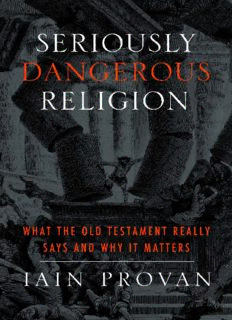
Seriously Dangerous Religion: What the Old Testament Really Says and Why It Matters PDF
Preview Seriously Dangerous Religion: What the Old Testament Really Says and Why It Matters
Seriously Dangerous Religion This page intentionally left blank Seriously Dangerous Religion What the Old Testament Really Says and Why It Matters Iain Provan Baylor University Press © 2014 by Baylor University Press, Waco, Texas 76798 All Rights Reserved. No part of this publication may be reproduced, stored in a retrieval system, or transmitted, in any form or by any means, elec- tronic, mechanical, photocopying, recording or otherwise, without the prior permission in writing of Baylor University Press. Cover Design by theBookDesigners Cover Image: “The Death of Samson (Judges XVI),” from The Bible Gallery, illustrated by Gustave Doré and descriptive letterpress by Talbot W. Cham- bers (New York: Cassell and Company, 1880). Image provided by Shutter- stock/Nicku. eISBN: 978-1-4813-0024-7 (ePDF) This E-book was converted from the original source file by a third-party vendor. Readers who encounter any issues with formatting, text, linking, or readability are encouraged to notify the publisher at BUP_Production@ baylor.edu. Some font characters may not display on all e-readers. To inquire about permission to use selections from this text, please contact Baylor University Press, One Bear Place, #97363, Waco, Texas 76798. Library of Congress Cataloging-in-Publication Data Provan, Iain W. (Iain William), 1957– Seriously dangerous religion : what the Old Testament really says and why it matters / Iain Provan. 512 pages cm Includes bibliographical references and index. ISBN 978-1-4813-0022-3 (hardback : alk. paper) 1. Bible. Genesis—Theology. 2. Bible. Genesis—Criticism, interpretation, etc. 3. Bible. Old Testament—Criticism, interpretation, etc. I. Title. BS1235.52.P76 2014 221.6—dc23 2013020060 For Loren and Mary Ruth This page intentionally left blank Contents Acknowledgments ix 1 Of Mice, and Men, and Hobbits 1 Stories, Art, and Life 2 The Up Quark, the Down Quark, and Other Cool Stuff 21 What Is the World? 3 Slow to Anger, Abounding in Love, and (Thankfully) Jealous 47 Who Is God? 4 Of Humus and Humanity 77 Who Are Man and Woman? 5 It Isn’t Natural 105 Why Do Evil and Suffering Mark the World? 6 On Living in a Blighted World 133 What Am I to Do about Evil and Suffering? 7 Even the Stork Knows That 163 How Am I to Relate to God? 8 Love All, Trust a Few, Do Wrong to None 191 How Am I to Relate to My Neighbor? vii viii Contents 9 On Keeping the Earth 221 How Am I to Relate to the Rest of Creation? 10 I Saw the New Jerusalem 251 Which Society Should I Be Helping to Build? 11 A Bird Perched in the Soul 279 What Am I to Hope For? 12 Further Up and Further In 309 New Dimensions in the Old Story 13 On the Judicious Closing of the Mind 347 The Question of Truth 14 Risk Assessment 379 Is the Story Dangerous? Postscript: Biblical Faith for a New Age 407 Notes 411 Bibliography 461 Scripture Index 481 Index of Authors 495 Subject Index 499 Acknowledgments This book—and another closely related one, Convenient Myths: The Axial Age, Dark Green Religion, and the World That Never Was (Baylor University Press, 2013)—has been a long time in the making, and I have many people and institutions to thank for help and support along the way. On the institutional side, first of all, I want to thank my employ- ers at Regent College for their support for the project in terms of two periods of sabbatical leave in the winter semesters of 2009 and 2012. Thanks are also due, with respect to the second of these sabbaticals, to the University of Erfurt in Germany, and in particular to my host there, Christoph Bultmann, and his wife, Ursula, both of whom went out of their way to make my wife and me welcome. I must also thank most warmly the Alexander von Humboldt-Stiftung in Germany, which funded my stay in Erfurt, and the Lilly Foundation, whose Theological Research Grants Program covered our travel and other expenses. On the personal side of things I want to thank five research assis- tants at Regent College who completed an enormous amount of work on this project. Merely to name each one does not seem sufficient, but this is what one does, apparently: Jen Gilbertson, Alex Breitkopf, Rachel Toombs, Benjamin Petroelje, and Stacey Van Dyk. I also want to thank various colleagues, friends, and students who read the book proposal or ix
Description: